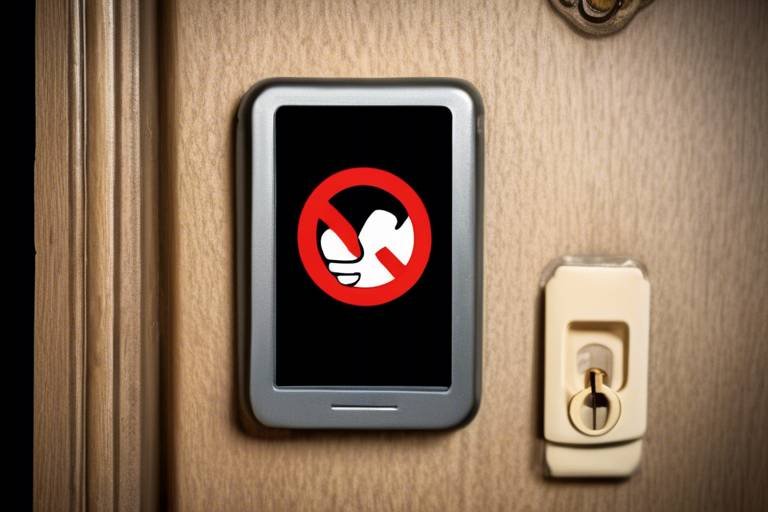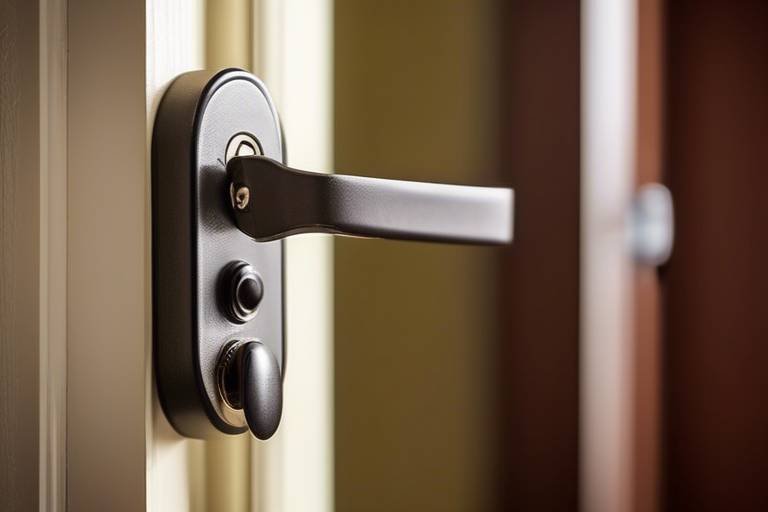Safe Gardening Tips - Avoiding Unwanted Accidents at Home
Gardening can be one of the most rewarding hobbies, offering a chance to connect with nature, grow your own food, and beautify your surroundings. However, it’s essential to remember that with all the joy gardening brings, it also comes with its own set of risks. Accidents can happen in the blink of an eye, turning a peaceful day in the garden into a trip to the emergency room. That’s why we’ve compiled a list of safe gardening tips to help you avoid unwanted accidents at home. By following these guidelines, you can ensure a safe and enjoyable gardening experience for everyone involved.
First things first, let’s talk about what you might encounter in your garden. Identifying potential hazards is crucial for a safe gardening experience. Common risks include sharp tools that can cause cuts, slippery surfaces that can lead to falls, and toxic plants that can pose health risks if handled improperly. For instance, did you know that some seemingly harmless plants like oleander or foxglove can be highly toxic? Understanding these risks is the first step in preparing for a safer gardening adventure. Always keep an eye out for these hazards, and don’t hesitate to take precautions, like keeping tools organized and cleaning up spills immediately.
Now that you’re aware of the hazards, let’s dive into the importance of wearing the right safety gear. Just like a knight dons armor before heading into battle, you should equip yourself with protective gear to minimize the risk of injuries. Essential items include gloves to protect your hands, goggles to shield your eyes from flying debris, and sturdy footwear to prevent slips and falls. Investing in quality safety gear is like having a trusty sidekick; it helps you tackle your gardening tasks without fear. Remember, safety should always come first!
When it comes to gloves, not all are created equal. Selecting gloves that fit properly and provide adequate protection is essential. You might be tempted to grab any old pair lying around, but trust me, your hands will thank you for choosing wisely. There are various types of gloves available, each suited for different gardening tasks. For instance, if you’re handling thorny bushes, thorn-proof gloves are a must. On the other hand, if you're planting delicate seedlings, lightweight gloves will offer the dexterity you need. Always assess the task at hand before choosing your gloves.
Understanding the materials used in gardening gloves can help you choose the most suitable option for your tasks. Here’s a quick breakdown:
| Material | Pros | Cons |
|---|---|---|
| Leather | Durable and protective | Can be hot and stiff |
| Latex | Flexible and waterproof | Not puncture-resistant |
| Cotton | Breathable and comfortable | Less protection against thorns |
By knowing the pros and cons of each material, you can select gloves that best suit your gardening style.
A good fit ensures comfort and safety while gardening. It’s essential to try on gloves to find the perfect balance between protection and dexterity. Think of it like finding the right pair of shoes; if they’re too tight, you’ll be uncomfortable, and if they’re too loose, you might lose your grip and end up with an injury. So, make sure to test out different sizes and styles until you find the perfect match!
Just like gloves, wearing appropriate footwear is crucial for preventing slips and injuries. You wouldn’t want to wear flip-flops while mowing the lawn, right? The best types of shoes for gardening are those that offer good grip and support. Look for shoes with non-slip soles and sturdy construction. Waterproof options are a bonus, especially for those rainy days when your garden needs a little TLC. Remember, your feet are your foundation; keep them safe!
Using gardening tools correctly is essential for safety. Improper handling can lead to accidents that could easily be avoided. Ensure you’re familiar with each tool’s function and how to use it safely. Additionally, regular maintenance of your gardening tools can prevent accidents. A sharp tool is a safe tool, so take the time to clean and sharpen your tools regularly. Not only does this keep them in good working order, but it also makes your gardening tasks easier and more enjoyable.
Regular maintenance of your gardening tools can prevent accidents. Here are some quick tips on how to keep your tools in tip-top shape:
- Clean tools after each use to prevent rust and buildup.
- Sharpen blades regularly to ensure they cut cleanly.
- Store tools in a dry place to avoid moisture damage.
By keeping your tools maintained, you’re not just prolonging their life; you’re also ensuring a safer gardening environment.
Understanding how to handle tools safely is key to avoiding injuries. Always use tools for their intended purpose, and never try to improvise. For instance, using a shovel as a lever can lead to accidents. Always keep your tools organized and out of walkways to prevent tripping. If you’re passing a tool to someone, make sure to hand it to them, rather than tossing it, to avoid any accidents.
Being prepared for accidents is essential in any gardening activity. Despite your best efforts, accidents can still happen, and knowing how to respond can make all the difference. This is where having a first aid kit comes in handy. Make sure to stock it with essential items like band-aids, antiseptic wipes, and gauze. Familiarize yourself with basic first aid procedures for common gardening injuries, such as cuts, scrapes, or insect bites.
A well-stocked first aid kit can be a lifesaver in emergencies. Here’s a list of essential items to include in your gardening first aid kit:
- Adhesive bandages
- Antiseptic wipes
- Gauze pads and tape
- Hydrocortisone cream for insect bites
- Scissors and tweezers
Having these items on hand can help you respond effectively to minor injuries before they become serious.
Knowing basic first aid techniques can help you respond effectively to injuries. For instance, if you encounter a cut, clean the wound with antiseptic and cover it with a bandage. If you get stung by a bee, remove the stinger and apply a cold compress to reduce swelling. Familiarize yourself with these simple procedures so you can act quickly and confidently when needed. Remember, being prepared is half the battle!
Q: What should I do if I encounter a poisonous plant?
A: If you come into contact with a poisonous plant, wash the area with soap and water immediately and seek medical advice if necessary.
Q: Do I really need to wear gloves while gardening?
A: Yes! Gloves protect your hands from cuts, blisters, and potential toxins from plants.
Q: How often should I maintain my gardening tools?
A: Ideally, you should clean and inspect your tools after each use and sharpen them regularly to keep them in good condition.
Q: What items should I include in my first aid kit?
A: Essential items include adhesive bandages, antiseptic wipes, gauze pads, and scissors. Make sure to customize your kit based on your gardening activities.

Understanding Gardening Hazards
This article provides essential gardening safety tips to prevent accidents and injuries while gardening at home. Follow these guidelines to ensure a safe and enjoyable gardening experience for everyone involved.
Gardening can be a wonderfully therapeutic activity, but it’s not without its hazards. Understanding these risks is the first step towards ensuring a safe gardening experience. From sharp tools that can cause cuts to slippery surfaces that might lead to falls, being aware of potential dangers can save you a lot of trouble. Just think of your garden as a beautiful landscape filled with both treasures and traps. By identifying these hazards, you can prepare yourself and your loved ones for a safer adventure in your green space.
One of the most common risks in the garden comes from using sharp tools. Whether you're wielding a spade, a pair of shears, or a hoe, the potential for injury is always present. It’s crucial to handle these tools with care and to keep them well-maintained. For example, a dull blade can slip unexpectedly, causing a mishap. Additionally, be mindful of where you place these tools after use. Leaving them lying around can lead to trips and falls, especially if you have children or pets running around.
Another hazard that often goes unnoticed is the ground itself. Wet or uneven surfaces can be slippery, increasing the risk of falls. It’s wise to keep pathways clear of debris and to use non-slip mats in areas that tend to get muddy. If you’re working in a particularly damp area, consider wearing shoes with good grip to help prevent slipping. Remember, a little caution goes a long way in avoiding accidents!
Moreover, let’s not forget about toxic plants. While many plants are beautiful, some can be harmful to humans and pets if ingested. It’s essential to familiarize yourself with the flora in your garden. For instance, plants like oleander and foxglove are stunning but can be deadly if consumed. If you have children or pets, consider replacing these dangerous plants with safer alternatives to ensure everyone’s safety.
Lastly, it’s important to be aware of the environmental hazards that can arise during gardening. This includes exposure to harmful chemicals, such as pesticides and fertilizers. Always read the labels and follow the instructions carefully. Consider wearing a mask and gloves while applying these substances to minimize exposure. Keeping your garden safe is not just about avoiding physical accidents; it’s also about protecting yourself from harmful chemicals.
In summary, understanding gardening hazards is about being proactive. By recognizing the risks associated with tools, surfaces, plants, and chemicals, you can create a safer environment for yourself and your loved ones. So, before you dig in, take a moment to assess your surroundings and arm yourself with knowledge. After all, a little awareness can turn your gardening experience from a potential hazard into a joyful and safe endeavor!
Wearing the right safety gear is vital for protecting yourself while gardening. This section covers the necessary equipment, including gloves, goggles, and sturdy footwear, to minimize the risk of injuries.
Selecting gloves that fit properly and provide adequate protection is essential. This subsection discusses the types of gloves available and their specific uses in gardening tasks.
Understanding the materials used in gardening gloves can help you choose the most suitable option for your tasks. This section highlights the pros and cons of various glove materials.
A good fit ensures comfort and safety while gardening. This subsection emphasizes the importance of trying on gloves to find the perfect balance between protection and dexterity.
Wearing appropriate footwear is crucial for preventing slips and injuries. This section discusses the best types of shoes for gardening, focusing on grip and support.
Using gardening tools correctly is essential for safety. This section outlines the best practices for handling tools, including maintenance tips to keep them in good working order.
Regular maintenance of your gardening tools can prevent accidents. This subsection provides tips on cleaning, sharpening, and storing tools safely.
Understanding how to handle tools safely is key to avoiding injuries. This section discusses techniques for using tools effectively while minimizing the risk of accidents.
Being prepared for accidents is essential in any gardening activity. This section emphasizes the importance of having a first aid kit and knowing basic first aid procedures for common gardening injuries.
A well-stocked first aid kit can be a lifesaver in emergencies. This subsection outlines essential items to include in your gardening first aid kit.
Knowing basic first aid techniques can help you respond effectively to injuries. This section covers simple procedures for treating cuts, scrapes, and other common gardening-related injuries.
Q: What should I do if I get cut while gardening?
A: Clean the wound with soap and water, apply an antiseptic, and cover it with a bandage. If the cut is deep or bleeding heavily, seek medical attention.
Q: How can I prevent slips and falls in my garden?
A: Keep pathways clear, use non-slip mats, and wear shoes with good grip. Regularly check for and remove any hazards like wet leaves or tools left on the ground.
Q: Are there any plants I should avoid in my garden?
A: Yes, be cautious of toxic plants like oleander, foxglove, and certain types of mushrooms. Research plants before adding them to your garden, especially if you have pets or children.
Q: What safety gear do I need for gardening?
A: Essential safety gear includes gloves, goggles, and sturdy footwear. Depending on your tasks, you may also want to consider knee pads and a wide-brimmed hat for sun protection.

Essential Safety Gear
When it comes to gardening, safety should always be at the forefront of your mind. Just like a knight dons armor before heading into battle, you need to equip yourself with the right safety gear to fend off potential injuries. Imagine standing in your garden, surrounded by vibrant flowers and lush greenery, yet feeling secure and protected. That’s the magic of having the right gear!
First and foremost, let’s talk about gloves. These are not just any gloves; they’re your first line of defense against sharp tools and prickly plants. A good pair of gardening gloves will not only protect your hands from cuts and scrapes but also keep them clean and dry. When choosing gloves, look for ones that fit snugly but allow for movement, giving you the dexterity needed for delicate tasks. Remember, a glove that’s too big can slip off and expose your skin to hazards.
Next up, we have goggles. You might think they’re only for construction sites, but in the garden, they’re equally important. Whether you’re pruning bushes or using a weed trimmer, debris can fly up and hit your eyes. Protecting your vision is crucial, so invest in a sturdy pair of goggles to shield your eyes from dust, dirt, and plant particles. It’s a small price to pay for peace of mind!
And let’s not forget about footwear. The ground can be unpredictable, with slippery patches and uneven surfaces. Wearing sturdy, non-slip shoes is essential to avoid falls and injuries. Look for shoes with good traction and support, as they will help you navigate your garden safely. You wouldn’t want to slip while reaching for that perfect tomato, right?
In summary, your gardening safety gear should include:
- Gloves: Protect your hands from cuts and dirt.
- Goggles: Shield your eyes from debris.
- Footwear: Choose sturdy, non-slip shoes for stability.
By investing in these essential safety items, you’re not just protecting yourself; you’re also ensuring that your gardening experience is enjoyable and stress-free. Remember, a little preparation goes a long way in keeping accidents at bay. So gear up and get ready to dig into your gardening adventures with confidence!

Choosing the Right Gloves
When it comes to gardening, your hands are your most valuable tools. So, why would you risk them by not wearing the right gloves? Choosing the right gloves is not just about style; it’s about safety, comfort, and functionality. Imagine trying to dig in the soil or prune those pesky bushes without proper protection. It’s like going into battle without armor! The right gloves can make all the difference between a pleasant gardening experience and a painful one.
First, consider the type of gardening tasks you’ll be doing. Are you pulling weeds, planting flowers, or handling thorny plants? Each task may require a different type of glove. For instance, if you're dealing with prickly roses, you’ll want gloves that offer extra protection on the fingers and forearms. On the other hand, if you’re planting delicate seedlings, you might prefer a lighter glove that provides dexterity. Here’s a quick breakdown of common glove types:
- Leather Gloves: Durable and perfect for heavy-duty tasks.
- Rubber Gloves: Great for wet conditions and protecting against chemicals.
- Fabric Gloves: Lightweight and breathable, ideal for light gardening tasks.
Next, let’s talk about fit and comfort. You wouldn’t wear shoes that are too big or too small, right? The same applies to gloves. A good pair of gardening gloves should fit snugly without being too tight. This ensures you have the dexterity needed to grasp tools and handle plants effectively. To find the right fit, try on different sizes and styles, and don’t hesitate to move your fingers around. Can you easily grasp a trowel or pull a weed? If not, keep searching!
Another aspect to consider is the material of the gloves. Each material has its pros and cons. For example, leather gloves are incredibly durable but may not be as breathable as fabric ones. On the flip side, while rubber gloves provide excellent protection against moisture, they can be slippery when handling tools. Here's a quick comparison:
| Material | Pros | Cons |
|---|---|---|
| Leather | Durable, protective | Less breathable |
| Rubber | Water-resistant, easy to clean | Can be slippery |
| Fabric | Lightweight, breathable | Less protective |
Ultimately, the right gloves should feel like a second skin—protective yet flexible. Don’t forget to consider any allergies you might have as well. Some materials could irritate your skin, so always check for any adverse reactions before diving into a long gardening session. Remember, the goal is to enjoy your time in the garden without worrying about cuts, scrapes, or discomfort. So take your time, try on different options, and choose wisely!

Material Matters
When it comes to gardening gloves, the material you choose can make a world of difference in your gardening experience. Just like a chef wouldn’t use a dull knife, a gardener should not underestimate the importance of selecting the right glove material. Each type of glove offers unique benefits and drawbacks, which can significantly affect your comfort and safety while working in the garden.
For instance, latex gloves are popular for light tasks. They are stretchy, providing excellent dexterity, but they can be less durable when dealing with thorny plants or rough materials. On the other hand, leather gloves are robust and offer great protection against cuts and scrapes, making them ideal for heavy-duty gardening tasks. However, they can be bulky, which may hinder fine motor skills.
Another option is nitrile gloves, which are resistant to punctures and chemicals, making them suitable for handling fertilizers and pesticides. They strike a balance between flexibility and protection, allowing you to maintain a good grip on tools and plants. However, they may not be as breathable, leading to sweaty hands during hot summer days.
To help you navigate the glove material landscape, here’s a quick comparison:
| Material | Pros | Cons |
|---|---|---|
| Latex | Flexible, good for light tasks | Less durable, not thorn resistant |
| Leather | Durable, excellent protection | Bulky, less dexterity |
| Nitrile | Puncture resistant, good grip | Less breathable, can cause sweating |
Ultimately, the right material depends on the gardening tasks you plan to undertake. If you're pruning roses, a sturdy leather glove might be your best friend. But for planting seeds, a pair of latex gloves could be just what you need to keep your hands clean. Remember, it’s all about finding the perfect balance between protection and comfort. So, next time you head to the gardening store, think about what materials will suit your needs best. Your hands will thank you!

Fit and Comfort
When it comes to gardening, the right gloves can make all the difference, not just in terms of protection but also in comfort. Imagine spending hours in your garden, your hands feeling cramped and constrained by poorly fitting gloves. It's like trying to run a marathon in shoes two sizes too small! To avoid this discomfort, selecting gloves that fit well is crucial. A snug fit allows for better dexterity, which means you can easily grasp tools and handle plants without fumbling.
But how do you find that perfect fit? First, try on several pairs of gloves and pay attention to how they feel. You want them to be snug but not too tight; they should allow for some movement without slipping off. Look for gloves that have adjustable features, such as Velcro straps, which can help customize the fit around your wrist. This not only enhances comfort but also provides added protection from dirt and debris.
In addition to fit, consider the type of gardening tasks you’ll be performing. For instance, if you're working with thorny plants or heavy-duty tools, you might need gloves with extra padding or reinforced fingertips. On the other hand, if you're doing delicate work like planting seeds, lighter gloves that offer more tactile feedback would be ideal. Here’s a quick breakdown of how different glove types can cater to your gardening needs:
| Glove Type | Best For | Key Features |
|---|---|---|
| Leather Gloves | Heavy-duty tasks | Durable, cut-resistant |
| Rubber Gloves | Wet conditions | Waterproof, easy to clean |
| Gardening Gloves | General gardening | Flexible, breathable |
| Fingerless Gloves | Detailed work | Enhanced dexterity |
Ultimately, the right gloves should feel like a second skin. They should protect your hands without sacrificing comfort or flexibility. And remember, comfort goes beyond just fit; it also involves the materials used. Look for gloves made from breathable fabrics to keep your hands cool and dry, especially during those hot summer days spent in the garden. After all, who wants to deal with sweaty, uncomfortable hands when they could be enjoying the simple pleasure of planting flowers or harvesting vegetables?
So, the next time you're gearing up for a day of gardening, take a moment to consider the fit and comfort of your gloves. Invest in a quality pair that feels good and suits your gardening style, and you'll be amazed at how much more enjoyable your gardening experience can be. Happy gardening!
- What should I look for in gardening gloves? Look for gloves that offer a good fit, are made from durable materials, and provide the right level of protection for your gardening tasks.
- How do I clean my gardening gloves? Most gloves can be hand-washed with mild soap and water. Make sure to air dry them to maintain their shape and integrity.
- Can I use regular work gloves for gardening? While some work gloves may be suitable, gardening gloves are specifically designed for tasks like planting and pruning, offering better dexterity and protection.

Protective Footwear
When it comes to gardening, your feet are often the unsung heroes of the operation. They carry you through the garden, help you dig, plant, and prune, but they also need protection from the various hazards lurking in the soil and around your plants. Imagine stepping on a hidden thorn or slipping on wet grass; it can turn a peaceful gardening session into a painful ordeal. That’s why wearing the right protective footwear is not just a good idea; it’s essential for a safe and enjoyable gardening experience.
First and foremost, you want to choose shoes that offer excellent grip. Gardening often involves navigating uneven terrain, and a slip can lead to serious injuries. Look for shoes with rubber soles that provide traction. Additionally, consider footwear that is waterproof or resistant to mud and water. After all, gardening can get messy, and the last thing you want is to have soggy socks ruining your day.
Support is another critical factor in protective footwear. Gardening often requires bending, lifting, and standing for extended periods. Shoes with proper arch support can help reduce fatigue and prevent injuries to your feet and legs. Think of your shoes as the foundation of your gardening experience; a solid foundation leads to a successful garden!
Moreover, it’s important to consider the height of the footwear. While sneakers may be comfortable, they might not provide the ankle support you need when navigating through uneven ground or carrying heavy loads. Opt for ankle-high boots or shoes that offer more coverage. This will not only protect your feet but also shield your ankles from accidental bumps and scrapes.
Here’s a quick overview of some ideal types of protective footwear for gardening:
| Type of Footwear | Benefits |
|---|---|
| Gardening Boots | Waterproof, durable, and provides excellent ankle support. |
| Rubber Shoes | Easy to clean, slip-resistant, and great for muddy conditions. |
| Sturdy Sneakers | Good for breathability and comfort, but ensure they have grip. |
Lastly, don’t forget about the importance of comfort. You might be out in the garden for hours, so your shoes should feel like a second skin. Try on different styles and brands to find the perfect fit. Remember, a comfortable gardener is a happy gardener!
So, before you head out to tend to your plants, take a moment to think about your feet. Choosing the right protective footwear can make all the difference in your gardening experience. With the right shoes, you can focus on nurturing your garden rather than worrying about potential accidents. Happy gardening!
- What type of shoes are best for gardening? Look for shoes that offer good grip, support, and are waterproof. Gardening boots or rubber shoes are often ideal.
- Do I need to wear special socks with gardening shoes? While not mandatory, wearing moisture-wicking socks can enhance comfort and keep your feet dry.
- How often should I replace my gardening footwear? It’s best to replace them when you notice significant wear and tear or if they no longer provide adequate support.

Proper Tool Usage
Using gardening tools correctly is essential for ensuring not only your safety but also the efficiency of your gardening tasks. Think of your tools as extensions of your hands; if you don’t wield them properly, you could easily find yourself in a sticky situation. Just like a chef wouldn’t use a dull knife, you shouldn’t use tools that are in poor condition or that you don’t know how to handle. So, let’s dive into some best practices for tool usage that will keep you safe and make your gardening experience enjoyable!
First and foremost, always ensure that your tools are well-maintained. A tool that is clean and sharp operates more effectively and reduces the risk of accidents. For example, a dull blade requires more force to cut through plants, which increases the likelihood of slipping and injuring yourself. Regularly inspect your tools for any signs of wear and tear. If you notice something is off, it’s better to fix it than risk an injury. Here’s a quick checklist for maintaining your gardening tools:
| Tool | Maintenance Tip |
|---|---|
| Shears | Sharpen blades regularly to ensure clean cuts. |
| Spades | Keep the edge sharp and clean to prevent rust. |
| Rakes | Check for loose tines and tighten as necessary. |
Next, let’s talk about safe tool handling. Always use the right tool for the job. Trying to use a shovel for a task better suited for a hoe can lead to accidents and ineffective work. Furthermore, when you’re using tools, make sure to maintain a firm grip and a stable stance. This is especially important when you’re using heavy tools like axes or large pruners. Think of it this way: you wouldn’t try to balance on one leg while juggling, right? The same principle applies when you’re gardening. Stability is key!
Another important aspect of proper tool usage is your body positioning. When digging or lifting, bend your knees rather than your back. This simple adjustment can prevent serious injuries. It’s like lifting a heavy box; you wouldn’t just bend over and grab it—you’d squat down to lift it properly. Additionally, always be aware of your surroundings. Before you swing a tool, make sure there’s no one in your vicinity who could get hurt. It’s all about creating a safe environment for yourself and those around you.
Lastly, when you’re done using your tools, store them properly. Leaving tools lying around can create tripping hazards. Store sharp tools in a designated area where they won’t cause accidents. You can also use tool racks or boxes to keep everything organized. Not only does this protect others from injury, but it also prolongs the life of your tools by keeping them out of the elements.
In summary, proper tool usage is a vital part of gardening that shouldn’t be overlooked. By maintaining your tools, using them correctly, and being aware of your surroundings, you can significantly reduce the risk of accidents. Remember, gardening should be a fun and fulfilling activity, not a dangerous one. So gear up, stay safe, and enjoy the beauty of your garden!
- What should I do if I injure myself while gardening?
It's important to assess the injury first. For minor cuts or scrapes, clean the area and apply a bandage. For more serious injuries, seek medical attention immediately.
- How can I tell if my tools need maintenance?
If a tool is difficult to use, produces uneven results, or has visible signs of wear, it’s time for maintenance. Regular checks help prevent accidents.
- What are the best types of gloves for handling tools?
Look for gloves that provide a good grip and are made from durable materials. Leather gloves are excellent for heavy-duty tasks, while lighter gloves work well for delicate jobs.

Tool Maintenance
Maintaining your gardening tools is not just about keeping them shiny; it's about ensuring your safety and enhancing your gardening experience. Just like a chef wouldn’t use a dull knife, you shouldn’t use poorly maintained tools. Regular maintenance can prevent accidents and ensure that your tools work efficiently when you need them the most. Imagine trying to prune a stubborn branch with a rusty, dull pair of shears—frustrating, right? Not to mention, it can lead to slips and cuts. So, let’s dive into some essential maintenance practices that will keep your tools in top shape.
First off, cleaning your tools after each use is crucial. Dirt and debris can cause rust and corrosion, which can weaken the material over time. After you finish your gardening tasks, take a few minutes to wipe down your tools with a cloth. For stubborn dirt, a wire brush can be helpful. If your tools are particularly dirty, consider soaking them in soapy water before scrubbing. Remember, a clean tool is a happy tool!
Next, let’s talk about sharpening. Dull blades can lead to accidents as you might exert more force than necessary, increasing the chances of slipping. Regularly sharpen your shears, pruners, and hoes using a sharpening stone or a specialized tool sharpener. If you’re unsure about how to sharpen your tools properly, many online resources provide excellent tutorials. A sharp tool not only ensures safety but also makes your gardening tasks much easier and more enjoyable.
Finally, storing your tools properly is essential. After cleaning and sharpening, store your tools in a dry place to prevent rust. Hanging them on a wall or using a tool rack can keep them organized and easily accessible. Avoid leaving them in damp areas, as moisture can lead to rapid deterioration. If you have wooden handles, consider applying a bit of linseed oil to keep the wood from drying out and cracking.
To summarize, here are the key maintenance practices for your gardening tools:
- Clean your tools after each use.
- Sharpen blades regularly to ensure efficiency and safety.
- Store tools in a dry place to prevent rust and damage.
By following these simple yet effective maintenance tips, you can prolong the life of your gardening tools and maintain a safer gardening environment. Remember, a well-maintained tool is not just a tool; it’s a gateway to a more enjoyable gardening experience!
Q: How often should I clean my gardening tools?
A: Ideally, you should clean your tools after every use. This prevents dirt buildup and rust.
Q: What’s the best way to sharpen my gardening tools?
A: You can use a sharpening stone or a specialized tool sharpener. There are many tutorials available online to guide you through the process.
Q: How should I store my gardening tools?
A: Store your tools in a dry place, preferably hung on a wall or in a tool rack to keep them organized and prevent rust.

Safe Tool Handling
When it comes to gardening, using tools safely is as crucial as the plants you nurture. Imagine wielding a shovel like a knight with a sword; it can be a powerful ally, but if handled carelessly, it can lead to unfortunate accidents. To ensure you’re not just digging up the garden but also keeping yourself safe, let’s dive into some essential safe tool handling practices.
First and foremost, always inspect your tools before use. Just like you wouldn’t drive a car without checking the brakes, you shouldn’t start gardening without ensuring your tools are in good condition. Look for any signs of wear and tear, such as rust on blades or cracks in handles. A damaged tool can easily slip from your grip or break while in use, leading to potential injuries.
Next, it’s important to use the right tool for the job. Using a tool for something it wasn’t designed for is like trying to fit a square peg in a round hole—it just won’t work and can lead to accidents. For instance, using a spade to pry up rocks can damage the spade and cause it to snap, which might send pieces flying. Always choose the appropriate tool to ensure safety and efficiency.
When you’re using tools, maintain a clear workspace. A cluttered area can be a recipe for disaster. Keep your work area free of debris, and make sure you have enough space to maneuver safely. If you’re using sharp tools, ensure that others are at a safe distance. It’s not just about you; it’s about everyone around you too.
Moreover, always cut away from your body. This may sound like common sense, but it’s easy to forget in the heat of the moment. Whether you’re using shears, knives, or even a trowel, directing the blade away from your body minimizes the risk of injury if the tool slips. Think of it as a dance; you want to move gracefully and avoid any missteps that could lead to harm.
Finally, remember to store your tools properly after use. Leaving tools lying around can lead to accidents, especially if they’re sharp or heavy. Invest in a designated storage area, whether it’s a shed or a simple toolbox. Keeping your tools organized not only prolongs their life but also ensures that they’re out of reach of children and pets, reducing the risk of accidents.
By following these safe tool handling practices, you can enjoy your gardening experience without the worry of accidents. It’s all about being mindful and taking those extra moments to ensure your safety and the safety of those around you. Happy gardening!
1. What should I do if a tool slips while I'm using it?
If a tool slips, remain calm and assess the situation. If possible, step back and allow the tool to fall away from you. Avoid trying to catch it mid-air, as this can lead to injuries.
2. How can I tell if my tools need maintenance?
Regularly inspect your tools for signs of wear, such as rust, dull blades, or loose handles. If they don't operate smoothly or require excessive force to use, it’s time for maintenance.
3. Are there specific tools that are safer for beginners?
Yes! Start with basic tools like hand trowels and small pruners that are easy to handle. As you gain confidence, you can gradually introduce larger tools into your gardening routine.
4. What is the best way to store gardening tools?
Store tools in a dry, cool place, ideally in a shed or garage. Use hooks, shelves, or toolboxes to keep them organized and out of reach of children and pets.

First Aid Preparedness
When you dive into the world of gardening, it’s easy to get swept away by the beauty of blooming flowers and the satisfaction of nurturing plants. However, amidst the joy, accidents can happen—be it a minor scrape from a thorny rose or a more serious incident involving a sharp tool. This is why is not just a good idea; it’s a necessity. Imagine being in the middle of planting your favorite herbs and suddenly cutting your finger. Having a first aid kit nearby can turn a potential disaster into a minor inconvenience.
First aid isn't just about having a kit; it's about knowing how to use it effectively. A well-stocked first aid kit can be a lifesaver, but that’s only half the battle. You should also familiarize yourself with basic first aid techniques for common gardening injuries. For instance, if you accidentally slice your hand while pruning, knowing how to clean and dress that wound can prevent infection and ensure you’re back to gardening in no time.
To give you a clearer picture, here’s a breakdown of what should be included in your gardening first aid kit:
| Item | Purpose |
|---|---|
| Adhesive Bandages | To cover minor cuts and scrapes. |
| Antiseptic Wipes | To clean wounds and prevent infection. |
| Gauze Pads | For larger wounds that require more coverage. |
| Medical Tape | To secure gauze pads in place. |
| Scissors | For cutting tape or gauze. |
| Disposable Gloves | To protect yourself while treating wounds. |
| Cold Pack | To reduce swelling in case of sprains or bruises. |
Now, you might be wondering, “What else do I need to know about first aid?” It’s crucial to understand that not all injuries are the same. For example, if you encounter a bee sting while tending to your flowers, knowing how to remove the stinger and treat the area can make a significant difference in your comfort level. Similarly, if you experience a more severe injury, such as a deep cut, applying pressure and elevating the wound can be vital steps before professional help arrives.
In addition to having the right supplies, consider taking a first aid course. Many organizations offer classes that cover everything from basic wound care to CPR. Being equipped with this knowledge not only empowers you but also ensures that you can assist others in need. Gardening should be a peaceful and enjoyable activity, and knowing you can handle emergencies will give you peace of mind.
In summary, being prepared for accidents is an essential part of any gardening endeavor. By equipping yourself with a comprehensive first aid kit and understanding basic first aid techniques, you can turn potential accidents into manageable situations. So, before you dig into your next gardening project, take a moment to ensure you're ready for anything that might come your way!
- What should I include in my gardening first aid kit? A basic kit should include adhesive bandages, antiseptic wipes, gauze pads, medical tape, scissors, disposable gloves, and a cold pack.
- How can I treat a bee sting? Remove the stinger, clean the area with antiseptic, and apply a cold pack to reduce swelling.
- Is it necessary to take a first aid course? While not mandatory, a first aid course can provide valuable knowledge and skills for handling emergencies effectively.

Creating a First Aid Kit
Having a well-stocked first aid kit is not just a good idea; it's essential for any gardener. Picture this: you're deep in the soil, planting your favorite flowers when suddenly, you slice your finger on a sharp tool. Instead of panicking, you reach for your first aid kit, and voilà! You're back to enjoying your gardening adventure in no time. But what should you include in this lifesaving kit? Let's break it down.
First, start with the basics. A first aid kit should contain items that can handle the most common gardening injuries, such as cuts, scrapes, and insect bites. Here’s a quick rundown of essential components:
- Adhesive Bandages: These are a must-have for minor cuts and scrapes. They come in various sizes to cover different wound types.
- Antiseptic Wipes: To clean wounds and prevent infection, antiseptic wipes are crucial. They’re handy and easy to use.
- Gauze Pads and Tape: For larger wounds, gauze pads paired with medical tape can provide the necessary coverage and protection.
- Antihistamines: If you're prone to allergies, having antihistamines on hand can help with unexpected reactions from plants or insect bites.
- Burn Cream: Accidental brush against hot tools can happen, so a burn cream can soothe and protect your skin.
While these items are essential, don't forget to personalize your first aid kit based on your specific gardening activities and any personal health needs. For example, if you know you're allergic to bee stings, include an epinephrine auto-injector if prescribed by your doctor.
Now, let’s talk about storage. Keep your first aid kit in a cool, dry place where it’s easily accessible. A waterproof container is ideal, especially if you’re working outdoors. You wouldn't want your supplies to be damaged by moisture or dirt. Consider labeling your kit clearly so that anyone can find what they need in an emergency.
Lastly, remember that a first aid kit is only as good as your knowledge of how to use it. Familiarize yourself with basic first aid techniques. For instance, knowing how to clean a wound properly or how to apply a bandage can make all the difference in an emergency. You can even take a first aid course to boost your confidence and skills.
In conclusion, creating a first aid kit tailored for gardening is a proactive step towards ensuring safety while you enjoy your time in the garden. By being prepared, you not only protect yourself but also enhance your gardening experience, allowing you to focus on planting, pruning, and growing without unnecessary worry.

Basic First Aid Techniques
Gardening can be a delightful hobby, but it also comes with its fair share of risks. Accidents happen, and knowing how to respond can make all the difference. Understanding basic first aid techniques is essential for every gardener, whether you're dealing with minor scrapes or more serious injuries. Imagine you're knee-deep in soil, and suddenly you cut your finger on a sharp tool. Panic can set in, but if you know what to do, you can handle the situation calmly and effectively.
First and foremost, it's crucial to stay calm. Take a deep breath and assess the situation. If the injury is minor, like a small cut or scrape, begin by cleaning the wound. Rinse it under clean, running water for at least 5 minutes to remove any dirt or debris. This step is vital because it helps prevent infection. After rinsing, gently pat the area dry with a clean cloth or gauze. It’s important to avoid using cotton balls, as they can leave fibers in the wound.
Next, apply an antiseptic to the area. You can use a spray or cream, but make sure it’s suitable for the type of injury. Once the antiseptic is applied, cover the wound with a sterile bandage or adhesive strip. This will protect it from further injury and keep it clean. If the bleeding is more severe, apply gentle pressure with a clean cloth until it stops. If it doesn’t stop after 10 minutes, it’s time to seek professional medical help.
For more serious injuries, like deep cuts or punctures, the approach changes slightly. Do not attempt to remove any objects that may be embedded in the wound. Instead, apply pressure around the area to control bleeding. If the bleeding is profuse, elevate the injured area above the level of the heart. This can help slow down the blood flow. Always remember to keep the injured person calm, as anxiety can worsen the situation.
In the event of a sprain or strain, the R.I.C.E method is your best friend. R.I.C.E stands for Rest, Ice, Compression, and Elevation. First, rest the injured area to prevent further damage. Next, apply ice wrapped in a cloth to reduce swelling. Avoid putting ice directly on the skin to prevent frostbite. After icing, wrap the area with a compression bandage to provide support, and elevate it to minimize swelling.
Lastly, it’s a good idea to keep a well-stocked first aid kit in your gardening shed. Your kit should include items such as:
- Adhesive bandages in various sizes
- Antiseptic wipes or spray
- Gauze pads and tape
- Elastic bandages for sprains
- Scissors and tweezers
- Disposable gloves
By having these supplies on hand and knowing how to use them, you can ensure that you're prepared for any minor mishaps that may occur while gardening. Remember, the goal is to enjoy your time in the garden, and being equipped with basic first aid skills will help you do just that!
Q: What should I do if I get stung by a bee while gardening?
A: If you are stung, remove the stinger as quickly as you can by scraping it out with a flat object, like a credit card. Clean the area with soap and water, then apply a cold pack to reduce swelling. If you experience severe reactions, seek medical attention immediately.
Q: How can I treat a burn from hot soil or equipment?
A: Rinse the burn under cool running water for at least 10 minutes. Avoid using ice directly on the burn. Cover the burn with a sterile, non-stick bandage and seek medical attention if the burn is severe or blisters develop.
Q: Is it necessary to have a first aid kit for gardening?
A: Absolutely! Having a first aid kit readily available can help you address minor injuries quickly, preventing them from becoming more serious.
Frequently Asked Questions
- What are the common hazards I should look out for while gardening?
When gardening, you should be aware of various hazards such as sharp tools, slippery surfaces, and toxic plants. It's important to identify these risks to create a safer environment for yourself and others.
- Why is wearing safety gear important in gardening?
Wearing safety gear like gloves, goggles, and sturdy footwear is crucial because it protects you from injuries. Just like a knight wouldn't go into battle without armor, you shouldn't garden without your protective gear!
- How do I choose the right gardening gloves?
Choosing the right gardening gloves involves finding a pair that fits well and offers the protection you need for specific tasks. Consider the material and the type of gardening activities you’ll be doing to ensure you get the best fit.
- What kind of footwear is best for gardening?
For gardening, you want sturdy footwear that provides good grip and support. Think of it like choosing the right shoes for a hike; you need something that can handle the terrain while keeping your feet safe!
- How can I safely handle gardening tools?
Safe tool handling includes using the right technique and maintaining your tools properly. Regular cleaning and sharpening, along with storing them safely, can help prevent accidents and ensure they work effectively.
- What should I include in a gardening first aid kit?
A well-stocked gardening first aid kit should include items like band-aids, antiseptic wipes, gauze, and scissors. Think of it as your safety net; having these supplies can make a big difference in case of minor injuries!
- What are some basic first aid techniques I should know?
It's helpful to know how to treat cuts and scrapes, such as cleaning the wound, applying antiseptic, and covering it with a bandage. Knowing these simple techniques can empower you to handle minor injuries swiftly and effectively.



















